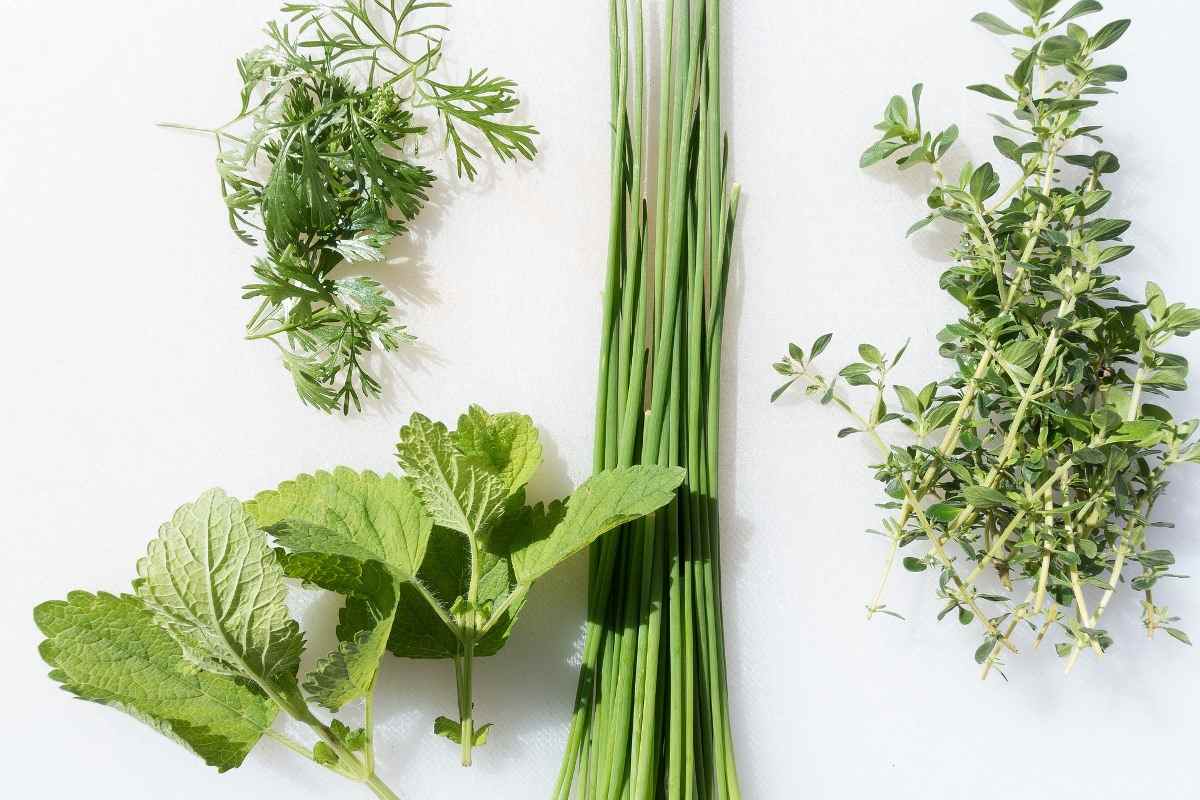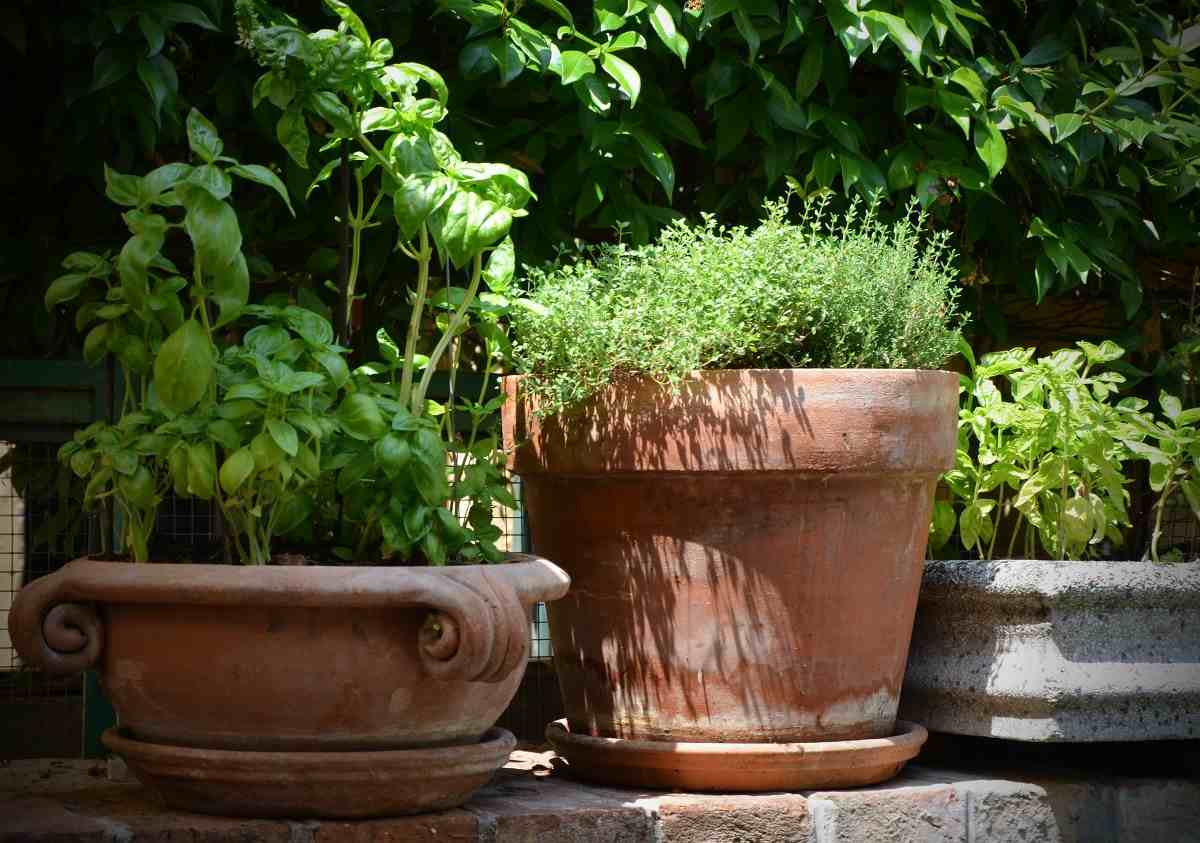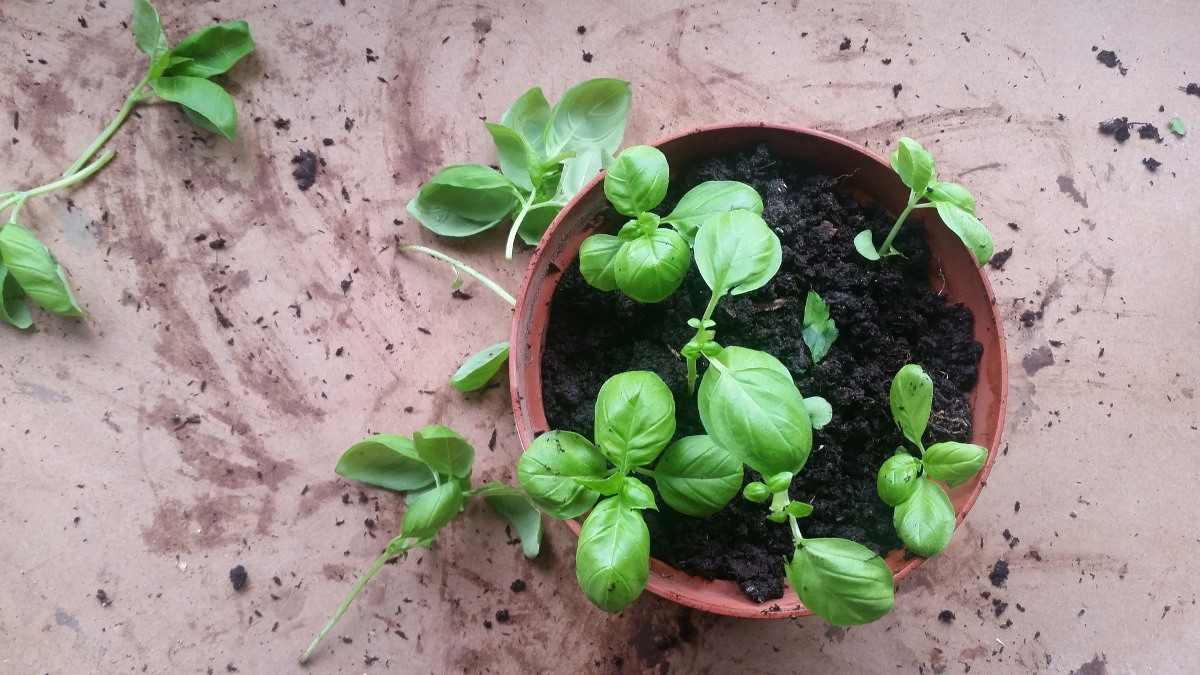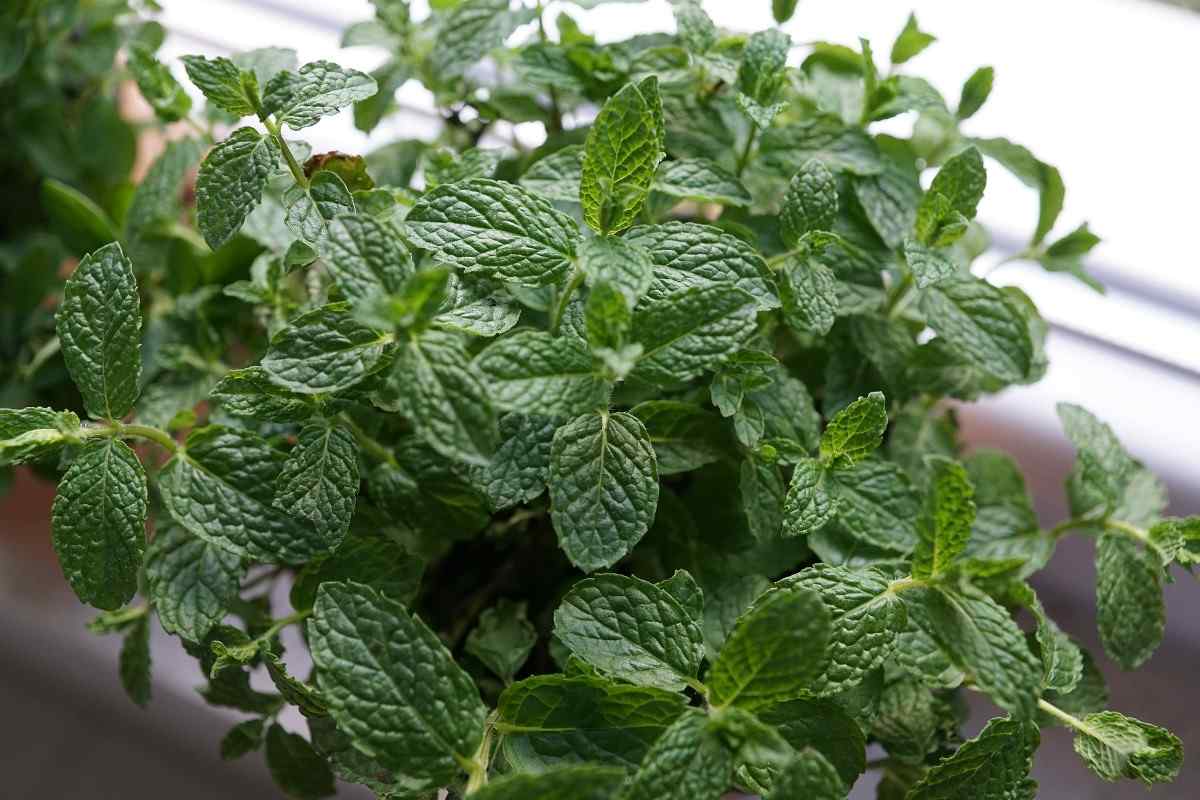Introduction to Growing Kitchen Herbs in Pots
Herbs are some of the easiest plants to grow in pots, and the most delicious. The ideal setting for an indoor herb garden is the kitchen, where you can snip fresh herbs and use them in many dishes. All you need is the right amount of sunlight, pots, some soil, and sufficient space in your kitchen to grow them indoors.
A Step by Step Guide to Growing Kitchen Herbs (Culinary) in Pots and Containers
When considering growing herbs in your kitchen, choose herbs that you frequently use in your cooking.
Conditions for Growing Kitchen Herbs in Pots
In natural light – South-facing windows have the brightest light and most hours of sun during the short, cool winter days. Good plants for these locations are rosemary, thyme, basil, bay laurel, and oregano.
East- and west-facing windows receive bright sun for about 6 hours in the morning or afternoon, but east windows remain cooler. Good plant choices include mint, parsley, chives, and chervil, which thrive with less intense light and prefer the cooler temperatures.
Under grow lights – Full-spectrum grows lights are ideal for all herbs. Start by having the lights on for 12 to 16 hours a day for bright-light herb plants.
You’ll need a bright space, such as a large sunny window, a sunroom or a room with skylights for growing herbs. Choose a location with temperatures between 55 and 75F with good air circulation. The area next to a window may be too cold for some herbs in winter.
Most culinary herbs grow best with at least 5 to 6 hours of bright light. A bright, sunny window or sunroom is an ideal location for growing kitchen herbs in pots. Southern facing windows are the best choice. You can add a small table directly in front of your window if the window sill is simply not large enough to comfortably fit your pots.
Potting Soil for Growing Kitchen Herbs in Pots
Herbs are among the easiest plants to grow. Most herbs love the sun, so all you need to get started is a sunny place in your house. Make sure to buy a tray to place underneath your pot that will collect and also drain off excess water. Next, make your potting soil by mixing 50% ordinary garden soil with 50% homemade compost. Wet waste from your kitchen (like tea leaves, eggshells, vegetable peels, stalks), when composted, makes great mulch for your herb plants.
Start potting by filling the container with the compost-soil mix about three-quarters of the way up. Then, moisten the soil lightly with water until moist but not wet. Taking care not to damage the plant roots, evenly space the herbs in the container and sprinkle enough potting soil to cover to the roots completely. After this, pat the soil down lightly and water the soil. Growing herbs successfully indoors begins with high-quality soil.
Remember, Herbs require soil that both holds sufficient root zone nutrients and moisture and allows the roots to breathe. Commercially available potting soil can fulfill these needs, but it is also possible to create a homemade potting mix. When making a potting mix, use peat moss, vermiculite, compost (or some other organic material), and a slow-release granular fertilizer.
Pots Size for Growing Kitchen Herbs
Almost any pot at least 6 inches or larger can be used for growing herbs as long as it has drainage holes. Select the largest pot possible to provide more room for growing roots, which will give you a bigger plant to harvest from.
Use a fast-draining potting mix as garden soil will compact in containers and smother roots. Look for a premium mix that includes lightweight ingredients like perlite or vermiculite to help loosen and aerate the final mix.
- 6-inch pots should be used with dwarf or shallow-rooted herbs like thyme or globe basil. One problem with a pot this small is that it will need more frequent watering than a deeper pot, and inconsistent water levels can lead to a less-than-healthy plant.
- 8 to 10-inch pots are perfect for almost any herb plant. The size of a container can be used to limit the size of a herb. Plenty of herbs will expand to fill larger pots over time even they don’t need the space.
- 12 to 18-inch pots are spacious enough to accommodate multiple herbs at once or to grow exceptionally large herb plants. Herbs like parsley, which has a deep taproot, will thrive in a deeper pot. Lemongrass also performs best in a larger-diameter container.
GardeningTips for Growing Kitchen Herbs in Pots
- Choose a sunny location. Position your pots directly beneath your window to maximize sunlight’s effectiveness.
- Choose the herb plants that you cook with the most frequently and try to find heirloom varieties whenever possible. Some of the herbs to grow indoors are basil, parsley, and rosemary.
- Use a container with good drainage. Make sure that you choose pots with drains and saucers. If you only have a sealed pot, place rocks at the base and toss some vermiculite into the soil to aid with drainage.
- Plant rosemary, thyme, oregano, and bay laurel in a blend of equal parts of regular potting soil and cactus mix. Let the soil dry a bit before watering. Other herbs grow well in regular potting soil. Keep soil slightly moist, but not soggy. Fertilize once or twice a month with a liquid houseplant fertilizer.
- Growing herbs indoors makes harvesting easy and is a great idea if you don’t have a garden or balcony. It also extends the season for annual herbs so you’ll have fresh produce all year round.
- Herbs are relatively low maintenance unless you’re growing them in containers, in which case they require routine watering and feeding.
How Often Should You Water Potted Herbs?
When it comes to watering, container herb gardens dry out faster and require more attention than backyard gardens. How much you water will depend on many factors including;
- Type of soil or potting mix used
- Amount of exposure to sun, rainfall, and wind
- Average temperature
- Size of your plant(s)
If temperatures are warm, a container may need water once or twice a day. Test the soil before you water your herbs to prevent overwatering. To do this, insert one finger up to the knuckle into the soil to test for dryness. Water your herb plants depending on how dry the soil is. Also, as soggy soil quickly leads to root rot, don’t let water accumulate at the bottom of the pot. One of the first signs of overwatering is leaves turning yellow.
Fertilizer Requirements for Growing Kitchen Herbs in Pots
Fertilizing indoor herbs provides plants with the nutrients they need for strong, healthy plant growth. While most herbs require little fertilizer, you do need to pay closer attention to container-grown herbs. Because the amount of soil around the plant is limited to the container size, it dries out faster and requires more nutrients than the soil in your garden. For herbs, usually, all that is needed is a good all-natural organic fertilizer which can be mixed in with the potting mix before planting. If your herb plants lose their color or look a little peeked during the growing season, apply a good liquid fish and kelp fertilizer at half the recommended strength every few weeks.
The best type of fertilizer to use for herbs is seaweed extract or fish emulsion. Both fertilizers have a higher concentration of nitrogen which promotes strong leafy growth. During active growth, such as the summer months you should fertilize once a week. For slower growth periods this can be reduced to once a month. Some herb gardeners prefer to make a week solution and include it every time they water.
Harvesting your Potted Herbs

There are a few things you should keep in mind when harvesting potted herbs;
- Harvest culinary herb plants just before the buds open. Once they bloom, all the plant’s energy goes into producing blooms, not developing those tasty plant leaves.
- Harvest seeds before they turn from green to brown color. Seeds must be brittle, dry, and crushable, but not brown.
- Fresh herbs are fragile, so when you harvest, handle them with proper care to avoid bruising your precious harvest. Depending on how mature your plants were when they were planted, you can start harvesting herbs right away. Use sharp scissors to snip the fragrant leaves off the plants.
The Best Kitchen Herbs to Growing in Pots

Here are a few popular herbs you can grow in pots;
Basil – Basil likes full sun and warmth, so give basil the sunniest spot in your kitchen herb garden. Basil will do well in a south-facing window. Basil also needs plenty of sunlight and requires upwards of 8 hours of full sun per day to thrive. Growing basil indoors is easy. Container grown basil should be planted in well-drained and nutrient-rich soil. Using the proper soil type is important to successfully grow basil in pots. Basil growing indoors will require fertilizing. Depending on the variety grown and its overall purpose, a general houseplant fertilizer can be used. Organic fertilizer also helps to maintain pH levels when growing basil in pots.
You should not miss this: Growing Luffa Gourd in Containers.

Lemongrass – Lemongrass grows best with abundant moisture, but not soggy soil. Care for indoor lemongrass plants is easy and productive. When planting lemongrass in pots, one of the best things you can do for your plant is to harvest it frequently, as this encourages new growth. Grow your lemongrass in full sun, with plenty of water, in rich, well-draining soil.
Curry Leaves/ Kadi Patta – The fragrant curry leaf plant needs abundant sunlight. When selecting and preparing a location for curry leaf plants, pick a spot with full sunlight, warm conditions, and very well-draining soil. Normally, curry leaf plants remain free from pests and diseases. Spraying diluted neem oil or horticultural oil on your curry plants will help to keep pests and diseases away. Also, use a saltwater shower once every two weeks instead of regular watering if you notice bugs, spots, bite marks, or any other signs of infestation.
Bay – Bay leaf plants are a member of the family Lauraceae. Bay Leaf plants are tolerant of most soil types. The ideal pH range is 6-7, but the plant is somewhat versatile and can stand a range of 4.5 to 8.3. It’s a perennial that does best using the container gardening method. The Bay needs air circulation to remain healthy.
Chives – Chives grow best in bright light, such as a south-facing window. Chives are perennial members of the onion family and are loaded with Vitamins A and C. Growing chives indoors make perfect sense so that you may have them near the kitchen. Chives can grow from seeds, bulbs or plant propagation. When starting Chives from seeds, plant them indoors first (for about 8-10 weeks). Indoors place the pot in a dark spot at a temperature range of 15 to 21°C once the seeds sprout move the container into the light. As soon as the chive plant reaches 6 inches, transplant it into the garden.
Mint – Mint plants grow rambunctiously and their trailing, fragrant stems make them attractive houseplants. Mint is a perennial, aromatic herb that belongs to the Mentha genus of Lamiaceae family. To plant Mint, you need containers that are wide and not so deep. Mint plant sends out sprawling vines that spread all around your container. The hanging pots are also suitable for growing Mint. Use good quality garden soil mix to grow Mint in pots. Mint prefers to grow in partial shade or light sun. However, these plants can withstand full sunlight as well.
You may also check this: Growing Organic Ginger In Containers.

Oregano – Oregano is member of the mint family. Oregano thrives under bright light, so a bright window with morning sun is perfect. Use a liquid fertilizer, or supplement the soil with controlled-release pellets. For growing organic oregano, use an organic fertilizer or fortify the soil with compost. Growing oregano is easy. Oregano can be grown from seeds, cuttings, or purchased container plants.
Cilantro or Coriander – You can grow coriander in full sun and well-drained soil with a pH of 6.2 to 6.8. Sow the seeds about half to one inch deep in the soil. Space the seeds at a gap of about 6 inches. Press the soil over the seeds and then cover with the half-inch layer of fine mulch.
Rosemary – Rosemary is one of the best herbs to grow indoors. Give it plenty of suns and it will give your kitchen a fresh and herbal smell. Rosemary is another great garnish. Rosemary plant should be grown in pot or container with good quality potting mixture. It is recommended to add compost & sand in potting soil. Rosemary can be grown in any container size according to the age of the plant.
Thyme – Thyme is a classic culinary herb plant that is a must-have in the indoor kitchen herb garden. It is extremely versatile becoming one of the most commonly used herbs in many kitchens. It is a low growing, well branching plant that does equally well in pots or the garden.
Tarragon – Tarragon can grow in partial shade but does best in full sun. Growing tarragon indoors allows you easy access to the herb and gives the plant protection from cold temperatures. Tarragon is an attractive herb with slender, slightly twisted leaves. Give tarragon growing indoors at least 6 to 8 hours of light. Fertilize the herb with a dilution of fish fertilizer every two weeks.
In case if you are interested in this: Hydroponic Spinach Farming, Growing Tips.